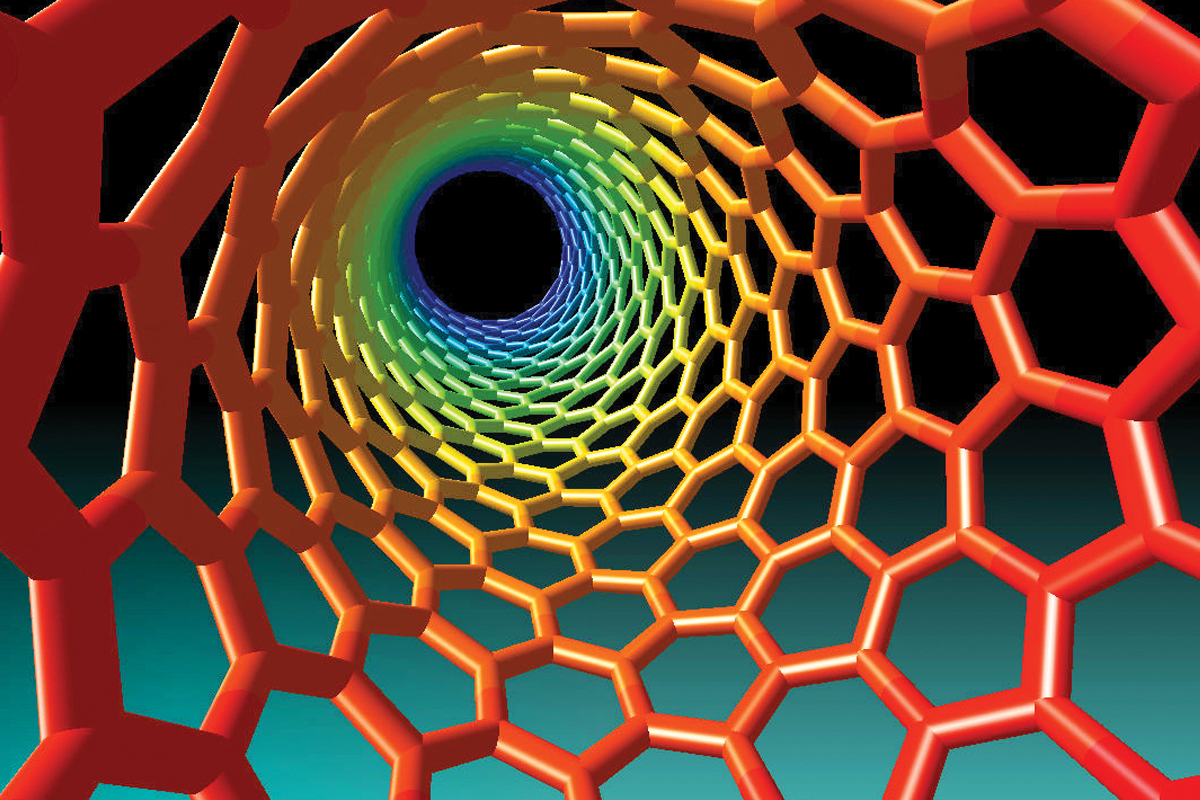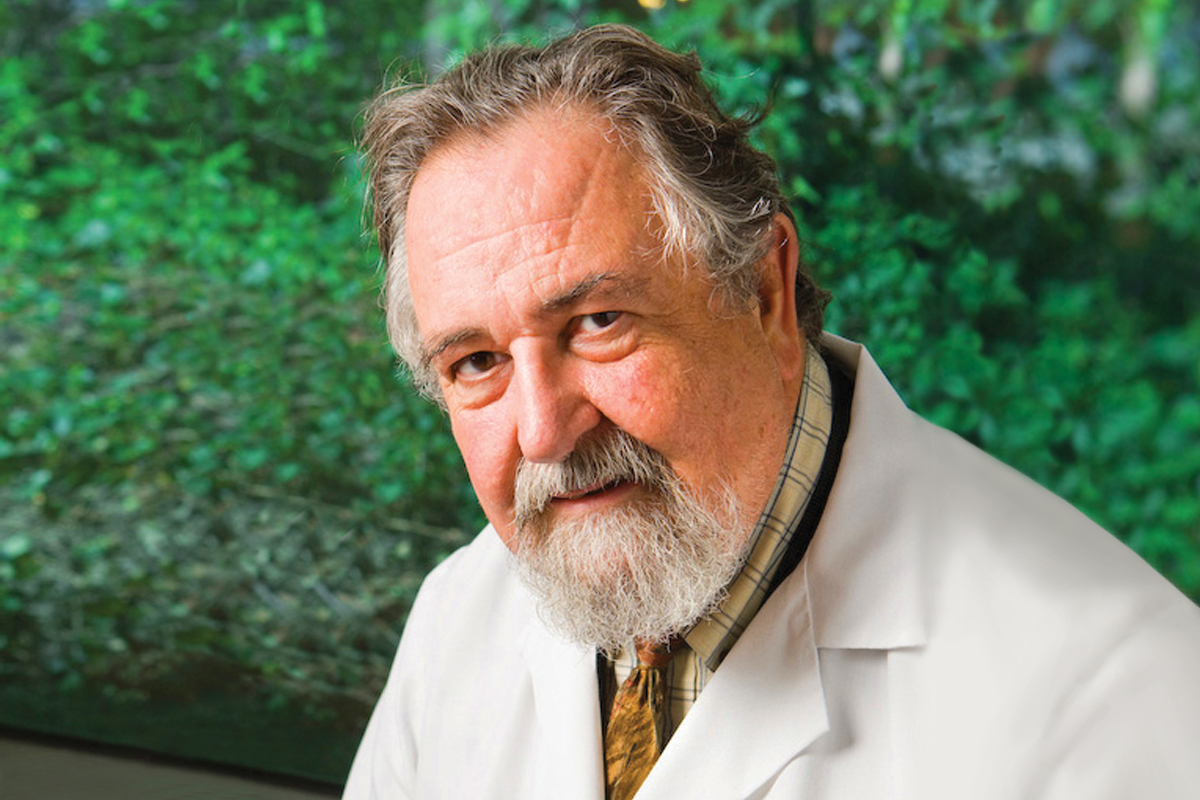
Hedvig Hricak (left) and David Scheinberg are members of the new Nanotechnology Center's executive committee, which Dr. Scheinberg chairs.
To take advantage of the growing field of nanotechnology, Memorial Sloan Kettering has established a Nanotechnology Center. The goal of the new center is to develop a program of nanoscience in cancer, allowing Memorial Sloan Kettering investigators to exploit recent advances in nanomaterials (such as nanotubes, shown below) and devices and begin to translate them into practical applications in patients.
Nanotechnology is the science of manipulating materials on an extremely small scale, based on the nanometer (one billionth of a meter). The field began taking off in the 1980s, but it has only been in the past few years that many of the technologies developed by chemists and materials scientists for other applications have begun to be applied in biomedical settings.

Nanotube
“The development of nanotechnology has reached a point at which many of the tools can be used in translational research to advance patient care,” according to Hedvig Hricak, Chair of the Department of Radiology in Memorial Hospital. “We have a critical mass of investigators interested in translational nanoscience. The new nanocenter not only provides a forum for them to talk about their projects and their ideas, but also facilitates collaboration with other institutions and offers resources for pilot projects. It’s moving forward extremely well.”
“The reason that the nanoscale is of such interest to us is that it is the scale on which the machinery of the cell operates,” explained David A. Scheinberg, Chair of the Molecular Pharmacology and Chemistry Program in the Sloan Kettering Institute. “The proteins that make DNA, the complexes that make proteins, and the receptors that allow the cell to communicate with and receive signals from the outside world all operate at the nanoscale. Indeed, chemotherapy drugs are actually much smaller than nanoscale; hence, these nanoscale drugs can be bigger and more complex than the kinds of drugs with which we usually work, and provide us with more-versatile, multi-functional agents for diagnosis and therapy.”
Dr. Scheinberg, who is also head of Memorial Sloan Kettering’s Experimental Therapeutics Center, is serving as Interim Chair of the new center, which was established in the spring of 2010. Dr. Hricak is a member of the Nanotechnology Center’s executive committee, along with chemist David Y. Gin, Nuclear Medicine Service Chief Steven M. Larson, and Human Oncology and Pathogenesis Program Chair Charles L. Sawyers.

Charles Sawyers member of the Nanotechnology Center’s execuitve committee
The two main focuses of nanotechnology research at Memorial Sloan Kettering are the development of more-specialized, targeted drugs and the development of more-accurate diagnostic agents. On the diagnostic side, applications include both in vitro applications, such as looking for circulating tumor cells or other markers in the bloodstream, and in vivo applications, using MRI, PET, and optical imaging to study cancer in the body. Another area under development involves what are called theranostic agents, which would allow imaging of a tumor and provide treatment to the tumor at the same time.
Investigators at Memorial Sloan Kettering are working with a number of different nanomaterials in their laboratories. Some are looking at carbon nanotubes, which have unique properties because they are very narrow but can be very long in relation to their diameter. Others are investigating the use of tiny silica-based beads called C dots. Still others are using a kind of nanoparticle called a micelle, or liposome, which is made of lipids (fat molecules) that can be dissolved by enzymes inside tumor cells once they reach their destination in the body.

David Gin member of the Nanotechnology Center’s execuitve committee
The benefit of using all these nanomaterials is that they can act as vehicles for delivering chemotherapy drugs, radioisotopes, and imaging agents directly to tumors. “Currently, we use monoclonal antibodies to deliver agents to the site of tumors,” Dr. Scheinberg said. “We can hook four or five drugs to an antibody. In contrast, we can hook hundreds of diagnostic or therapeutic agents to nanotubes or polymers.” Investigators are still using monoclonal antibodies as a way to deliver the nanoparticles to the site of the tumor. Nanomaterials can also be used to carry pieces of a complex treatment to a tumor site, where the components can be programmed to assemble after reaching their destination.
“One of the strengths of our program is that we are looking broadly at different carrier systems and we are using quantitative molecular imaging tools that have been developed here,” Dr. Larson said. “We can see exactly where these molecules are going, and when they are carrying a payload we can see how much of that payload they deliver to the tumor. We can also use antibodies and peptides that lock the nanoparticles and their payloads to the tumors, so they will remain where we want them to stay.”

Steven Larson member of the Nanotechnology Center’s execuitve committee
One concern about using nanomaterials for medical applications is their clearance or excretion from the body. A recent study in mice led by researcher Michael R. McDevitt, of the Leukemia and Radiochemistry Services, showed that nanotubes are filtered through the kidneys and excreted in the urine. Michelle S. Bradbury, a neuroradiologist working with the tiny silica C dots, has shown that these silica particles can also be prepared in a form that is excreted in the urine, having been coated with a polymer that prevents them from clumping or being recognized by the body as a foreign substance. The Food and Drug Administration recently approved a clinical trial using C dots to perform PET imaging in melanoma patients. It is the first nanoparticle product developed at Memorial Sloan Kettering to be approved for testing in patients.
More than a dozen investigators in both Sloan Kettering Institute and Memorial Hospital — in fields ranging from pathology and chemistry to surgery and radiology — are participating in the center. There also are plans to recruit research fellows who are interested in working on nanotechnology-related projects. Memorial Sloan Kettering has also established formal collaborative agreements with leaders in nanotechnology from other institutions: Joseph DeSimone of the University of North Carolina and Ulrich Wiesner of Cornell University, researchers who already were collaborating on research projects with many investigators at Memorial Sloan Kettering. (Dr. Wiesner was instrumental in the development of C dots.)
“Working with Drs. DeSimone and Wiesner will allow us to carry this technology forward, to create more benefits for patients,” explained Dr. Larson. “Everyone involved in the new center has different strengths, and the complementary nature of the work is so important. I am very excited about the work we have done so far, and I really feel good about the prospects for the future.”




